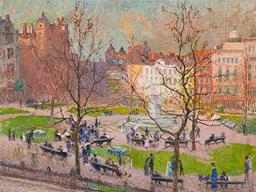Emile Claus
ArtValue.ca has 2 auction art sale records for their oil painting results, with prices in the range of C$50,000 to C$250,000.
Heffel Auction House Biography and Notes
Emile Claus was born in a small village in the Flanders region of Belgium, the twelfth child of a merchant. He showed early promise in drawing and attended weekend classes at a local art school, but his desire to become a professional artist was resisted by his father, who wanted to see him in a stable occupation. He was sent off to apprentice as a pastry chef in Lille, France, but this proved to be a very short and unsuccessful career (he was fired). Back home, Claus was able to reaffirm his artistic ambitions, eventually being allowed to attend the Antwerp Academy of Fine Arts. There, under Jacob Jacobs, he excelled at landscape painting and portraiture, and his natural talent as a realist painter developed rapidly. After his superb 1887 realist canvas Le pique-nique was bought by the Belgian royal family, his reputation was firmly established. Two years later, a winter stay in Paris gave him exposure to the work of the Impressionists, which inspired him to move beyond realism and to strike his own path. He had become fascinated by the play of light in the landscape and developed a focus on Zonneschym (sunshine), which gave his paintings from the 1890s the glowing quality and clarity that have led to him being dubbed the “Sun Painter.” In 1904, keen to promote luminism as a movement, he founded the Vie et Lumière group, which comprised like-minded Impressionist and luminist Belgian artists. October 1914 brought Claus’s comfortable life at the top of Belgian society to a shuddering halt. Although Antwerp was east of the main battles of the First World War, the city fell to the Imperial German Army and, with barely time to pack, he chose to go into exile in London, where he rented a studio overlooking the Thames. The move to England was to prove a fortunate choice that resulted in another successful period in his career. The many fine paintings he produced from 1914 to 1918 in London are now regarded as some of his greatest works. Leicester Square, the scene of this wonderfully luminous painting, is depicted from an elevated position with a glorious, early spring-like glow. Smart Edwardian society is expertly portrayed with just the finest dabs of paint, reminiscent of L.S. Lowry’s later portrayal of factory workers in the north of England. The nurse is there with her pram, children play in groups, couples stroll, and an elderly gentleman, bent over his cane, heads towards the central fountain, with its marble statue of William Shakespeare. Above this foreground bustle is another, equally captivating part of the scene, which depicts the shimmering play of crisp light against the historic buildings that enclose the square. The pinks, ochres, yellows and whites of the buildings’ facades all glow in the early afternoon sun, under a pale blue sky mixed with a light smoky haze. Despite being well-known to collectors of works by Claus, due to its being illustrated in colour in a 1919 edition of The Studio (London’s contemporary art and architecture magazine), this fine painting has not been seen in public for decades. It was acquired by another European émigré, the London-based and Polish-born concert pianist Jan Smeterlin. Known for his mastery of the piano works of Chopin, he gave his first public concert at the age of seven, and in 1912 played at London’s Wigmore Hall. His professional career and concert tours took him all over the world, including brief periods of residency in New York, and his recordings are still highly regarded, more than 50 years later. After his death in 1967, the painting remained in the family, passing to his widow and then to her niece in Canada.


